
She received five Academy Award nominations in ten years, winning for Best Actress twice. She was the spunky heroine to Errol Flynn’s dashing adventurer. She was Melanie, the sweet, compassionate counterpart to the spoiled, passionate Scarlett. And she became one of the oldest-living survivors of the Golden Age of Hollywood until her death at age 104 in 2020.
Olivia de Havilland was born July 1, 1916, in Tokyo, Japan, to British parents. Her sister, actress Joan Fontaine, was born 15 months later. Her parents divorced when the girls were young, and her mother eventually settled in California with her two daughters. Growing up, de Havilland enjoyed performing in amateur stage productions. Although she originally planned to become a teacher, a role in one of those amateur productions, “A Midsummer Night’s Dream”, changed her fate. She was discovered, eventually cast in the Hollywood Bowl production of that play, and then in the 1935 film adaptation.
Although her performance as Hermia was reviewed favorably, her next couple of projects were lackluster. However, that soon changed after the hugely successful swashbuckler “Captain Blood” paired her with Flynn, catapulting them both to stardom. She would make seven more films with Flynn in the next six years, including the classic “The Adventures of Robin Hood”, sealing their status as one of the greatest romantic pairings in film history.
Although she found success in her pairings with Flynn, as well as other period dramas and some screwball comedies, she longed to play something other than the supportive female love interest. She fought to play Melanie Hamilton Wilkes in “Gone with the Wind” when Jack Warner did not want to loan her out. Of course, this became one of the most successful films in history, and earned de Havilland her first Oscar nomination, this time for Best Supporting Actress.
Hoping the success of “Gone with the Wind” would lead to stronger roles, she was disappointed upon her return to Warner Bros. Over the next couple of years, she was suspended twice for rejecting scripts. Most of her roles in Warner Bros productions were unsatisfactory for her; she continued to look for more complex characters such as Melanie, but seemed to only find them when she was on loan to another studio. For example, she earned her second Oscar nomination for the Paramount picture “Hold Back the Dawn.”
When her seven-year Warner Bros. contract ended in 1943, the studio attempted to keep her six more months, citing her suspensions as reasonable cause. Most contracted players accepted this from the studios, but de Havilland fought, eventually winning her original suit as well as an appeal. This caused a major shift in Hollywood, resulting in the “seven year rule”, also known as the “De Havilland Law,” which lessened the power of the studios and gave more control to the performer. However, her victory almost cost her career – she was essentially blacklisted in Hollywood for two years.
In 1946, she came back with a bang with an Oscar-winning performance in “To Each His Own.” She then received back-to-back nominations in 1949 and 1950, for “The Snake Pit” and “The Heiress”, winning her second Best Actress Oscar for the latter.
She married and divorced twice, and had a child by each husband. She made fewer film appearances, taking time off to raise her children. In the 1960s, she received excellent reviews for a play she appeared in, wrote a best-selling book, appeared in a few more films and found success in television. Over the next couple of decades, she continued to work in both film and television, winning a Golden Globe in 1987 for Best TV Supporting Actress for her role in “Anastasia: The Mystery of Anna.” Her last screen performance was in the 1988 television movie “The Woman He Loved.”
Throughout the years, she and her sister Joan were also known for their ongoing sibling rivalry. According to biographers, they never got along, and their mother fueled the fire. They became the first siblings to be nominated in the same category at the same time at the 1942 Academy Awards. Fontaine won, and apparently did not act graciously towards de Havilland. This, among other incidents, led to years of estrangement, with brief periods of reconciliation. Sadly, however, the feud ended permanently with Fontaine’s death in 2013.
De Havilland remained active throughout her retirement years, doing interviews and making appearances at award shows and film retrospectives. In 2008, President George W. Bush presented her with the National Medal of Arts. In 2017, she was made a Dame by Queen Elizabeth II.
For many, de Havilland has been immortalized as the sweet Melanie in “Gone with the Wind”. However, her career has spanned over half a century, with memorable roles in almost every genre of film. For true film buffs, she is not only Melanie, but also the beautiful Hermia in the fantasy world of Shakespeare, spunky Maid Marian to Errol Flynn’s adventurous Robin Hood, homely heiress Catherine Sloper and diabolical cousin Miriam.
-
20. Lady in a Cage (1964)
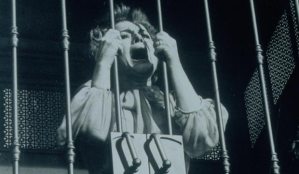
Image Credit: Moviestore/Shutterstock De Havilland plays a wealthy disabled woman who, due to a power outage, is stuck in the cage-like elevator of her private home. As she remains trapped, a group of derelicts breaks in, stealing from her and terrorizing her. This was one of de Havilland’s last starring roles, and one of the psychological horror films featuring ageing actresses that became popular in the 1960s. Although criticized at the time for its blatant brutality, it is now considered ahead of its time, realistically depicting a decaying society. “Lady in a Cage”, along with another de Havilland film “Hush. . .Hush, Sweet Charlotte”, and “Whatever Happened to Baby Jane?” (with Bette Davis and Joan Crawford), are considered classics among these campy 1960s thrillers.
-
19. The Proud Rebel (1958)

Image Credit: Moviestore/Shutterstock In this Michael Curtiz western, an ex-Confederate soldier and widower (Alan Ladd) moves north to find a doctor to cure his son’s (David Ladd) trauma-induced muteness. He makes an enemy of a local rancher, but is soon taken in and supported by landowner Linnett Moore (de Havilland), who is also the victim of the rancher’s nastiness. For the film de Havilland learned how to handle horses and guns. She shines in the type of role is well-known for- headstrong and feisty, yet gentle and compassionate, love interest to an underdog male fighting for justice. It holds up well today, and is a favorite among fans of the western genre.
-
18. Light in the Piazza (1962)

Image Credit: Mgm/Kobal/Shutterstock Meg (de Havilland) is the overprotective mother of a mentally disabled daughter, Clara (Yvette Mimieux). When they travel abroad, Clara is romanced by an Italian, who mistakes her mental disabilities for naivete. They fall in love, but Meg is concerned that his family will find out the truth and reject Clara, and battles to find the best way to guide her daughter to happiness. This was de Havilland’s first film in three years, and though not a huge success at the time, is now considered one of her finest performances.
-
17. The Dark Mirror (1946)

Image Credit: Universal/Kobal/Shutterstock In this psychological drama, de Havilland is cast as twin sisters, one of whom may have killed a man. A detective and a psychiatrist who specializes in twins try to determine if one is guilty, and if so, which one. One twin is sweet and kind; the other psychotic and manipulative. Although the film itself was criticized for being a bit muddled, de Havilland was praised for her performance. Her subtle acting style was on full display here, while portraying two completely different personalities, most notably in scenes in which she had to play the characters talking to each other.
-
16. In This Our Life (1942)

Image Credit: Snap/Shutterstock In the third of six films together, de Havilland and Bette Davis play sisters who are rivals in every way. Selfish, spoiled Stanley Timberlake (Davis) dumps her fiance and runs away with the husband of her kind and considerate sister Roy Kingsmill (de Havilland). Stanley ultimately drives him to suicide, and returns home to find Roy and her ex-fiance in love. Stanley does all she can to damage that relationship as well, with tragic consequences. Although the film did not do well at the time, it is now considered a very well-made melodrama of the era, with realistic depictions of racial bias and the consequences of alcohol abuse, both of which were daring subjects at the time. It was the second film of director John Huston, with whom de Havilland had a lengthy love affair.
-
15. It’s Love I’m After (1937)

Image Credit: Warner Bros/Kobal/Shutterstock This screwball comedy marks the first time good friends de Havilland and Bette Davis co-starred. Stage actors Joyce Arden and Basil Underwood (Davis and Leslie Howard) are as well-known for their tempestuous off-stage relationship as they are for their onstage pairings. As they are determined to finally get married after calling it off eleven times, Basil finds himself in a fix when Marcia West (de Havilland) becomes infatuated with him. He acts like a cad so that she will go back to her fiance and he can finally settle down with Joyce. Although screwball comedy was not a forte of any of the main actors, many fans and movie reviewers consider this a hidden gem, with delightful performances by all the leads.
-
14. They Died with Their Boots On (1941)
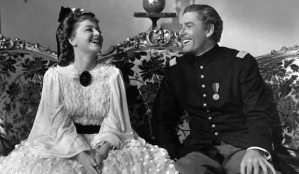
Image Credit: Moviestore/Shutterstock This marked the eighth and final pairing of Errol Flynn and de Havilland. It offers a highly fictionalized account of the life and death General George Custer (Flynn), from his time at West Point to his famous Last Stand, including his courtship of and marriage to Libbie Bacon (de Havilland). De Havilland had decided that she wouldn’t do any more films with Flynn, as she was tired of playing second fiddle to his lead, and Flynn respected that she wanted to have stronger lead roles. However, she learned that Flynn felt like he needed her in the film, and she agreed to do it. Their last time together onscreen is Custer’s farewell to his wife, marking a bittersweet screen ending to one of the most popular pairings in film history. Although it received much criticism due to its historical inaccuracies, the film was another box office success for Warner Bros. and received acclaim for its action scenes, acting, and cinematography. It is considered one of the pair’s best films by many.
-
13. The Charge of the Light Brigade (1936)
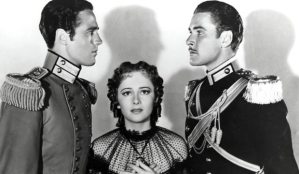
Image Credit: Moviestore/Shutterstock Very loosely based on Lord Tennyson’s poem, “The Charge of the Light Brigade” was de Havilland and Flynn’s second venture. She plays Elsa, who is in a love triangle with brothers Major Geoffrey Vickers (Flynn) and Captain Perry Vickers (Patric Knowles), both of whom are British officers stationed in India during the Crimean War. While British officers are away, a local rajah and his troops attack and massacre the British civilians on the base, and Geoffrey vows revenge. Elsa is spared as a repayment of a debt the rajah owes Geoffrey. The film climaxes with the Battle of Balaclava, which was the subject of Tennyson’s poem, and the brother’s love triangle, as well as Geoffrey’s vengeance, are resolved during this famous battle scene. “The Charge of the Light Brigade” was a financial success for Warner Bros, as well as bringing three Academy Award nominations, including a Best Assistant Director win for Jack Sullivan. This film proved the chemistry between de Havilland and Flynn was not a one time thing, leading to several more teamings, and confirmed their Hollywood pairing as one of the greatest in film history.
-
12. A Midsummer Night’s Dream (1935)
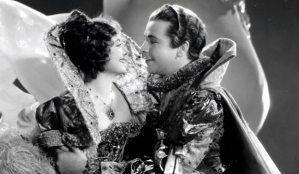
Image Credit: Moviestore/Shutterstock In this adaptation of William Shakespeare’s comedy, de Havilland portrays Hermia, who is engaged to Demetrius but in love with Lysander. This all-star fantasy included some actors not exactly known for Shakespearean work, including Dick Powell, James Cagney, and Mickey Rooney. It received mixed reviews at the time, but nonetheless picked up four Oscar nominations, including Best Picture, and won for Best Cinematography and Best Film Editing. Today, it is considered one of the finest adaptations for the big screen of Shakespeare’s work. It was de Havilland’s first motion picture, and she received good reviews for her work.
-
11. Dodge City (1939)

Image Credit: Warner Bros/Kobal/Shutterstock In a year with a lot of huge films, “Dodge City” was one of the top 10 grossing movies of that banner year. It was Errol Flynn and de Havilland’s first western. Dodge City is a cattle town run by the ruthless and lawless Jeff Surrett (Bruce Cabot). Irish cowboy Wade Hatton (Flynn) has helped bring the railroad to Dodge City, and is now bringing in several settlers, including love interest Abby Irving (de Havilland). Hatton eventually becomes sheriff, and with Abby’s help, finds evidence to put Surrett away. However, they have obstacles to overcome, and Hatton has to do all he can to protect Abby. Although Flynn was not at his most comfortable in westerns, his chemistry with de Havilland was undeniable, and made some of the less realistic stories more believable. “Dodge City” is one of the westerns that rebooted the genre, and is still a favorite among fans today.
-
10. My Cousin Rachel (1952)

Image Credit: Shutterstock In this mystery romance based on a Daphne du Maurier novel, young Philip Ashley (Richard Burton) believes his rich and much-loved cousin was murdered by his new wife Rachel (de Havilland) to gain an inheritance. However, when he meets Rachel, he too falls in love with her and no longer believes she could be capable of such a deed. However, is she only trying to gain favor with Philp so that she can murder him and gain his inheritance as well? The film received four Academy Award nominations, including Best Supporting Actor for Richard Burton in his Hollywood film debut, and de Havilland won a Golden Globe for her performance. Although it seemed this was one of those films lost to time, du Maurier’s works are finding a new audience, and this is considered one of the better film adaptations of his works. “My Cousin Rachel” was remade in 2017 with Rachel Weisz starring.
-
9. Hold Back the Dawn (1941)

Image Credit: Moviestore/Shutterstock This film marks de Havilland’s second Oscar nomination, and her first in the lead actress category. Romanian Georges Iscovescu (Charles Boyer) is stopped at the Mexican border trying to gain entry into the U.S. He meets visiting American teacher Emmy Brown (de Havilland), and romances her. She falls in love, and they quickly marry, although she is unaware that he is marrying her to gain entry into the U.S. When she discovers the scheme, she flees and is in a terrible car accident. By this time, he has fallen in love with her and risks his visa to sneak into the country to see her. Much of de Havilland’s appeal is in her ability to make a naive gullible character not only believable, but likeable. Besides de Havilland’s nomination, the film received five other bids, including Best Picture. Billy Wilder and Charles Beckett received a screenplay nomination; however, Wilder was furious when Boyer deleted a scene he didn’t like, and Wilder vowed to direct his own screenplays from then on. It was also the first time a pair of siblings received nominations in the same category – de Havilland’s sister Joan Fontaine won Best Actress for “Suspicion”, one of the many elements in their famous decades-long feud.
-
8. To Each His Own (1946)

Image Credit: Paramount/REX/Shutterstock De Havilland won her first Best Actress Academy Award for this bittersweet melodrama. She plays Jody Norris, a young woman who falls in love with a visiting aviator during WWI; he is eventually killed in action and she is left unwed and pregnant. A scheme to “adopt” the child backfires when another couple claims the child first. Although it breaks her heart, she gives up her son and watches his upbringing from afar. She becomes successful in the cosmetic industry, eventually moving to London. Years later, during the second World War, she learns her son will be there on leave and attempts to meet up with him. A man who is trying to court her learns what’s going on, and attempts to make her happy by helping her and the son. De Havilland realistically makes the transition from idealistic young girl in love to lonely hardened businesswoman, and her Oscar was well deserved. The film also received a nomination for its beautifully written script.
-
7. The Strawberry Blonde (1941)
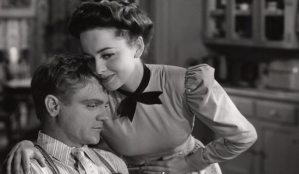
Image Credit: Madison Lacy/Warner Bros/Kobal/Shutterstock Olivia de Havilland, James Cagney and Rita Hayworth – what a great combination of talent! In this delightful romantic comedy, Biff (James Cagney) is a quick-tempered but good-hearted guy who, like every other guy in the neighborhood, has a crush on the “Strawberry Blonde” Virginia (Rita Hayworth). However, she chooses his more ambitious friend as a suitor. Biff is “stuck” with Virginia’s very outspoken feminist friend, Amy (de Havilland), who proves to be the better love interest in the end, and is a supportive wife through some harsh times. Set in 1890s New York, the film has a wonderful nostalgic feel, and holds up well under the test of time. It was a huge success, and boosted Hayworth’s career. Many highlights come from Biff and Amy’s unusual and hilarious courtship, with both Cagney and de Havilland displaying their comedic abilities.
-
6. Hush . . . Hush, Sweet Charlotte (1964)

Image Credit: 20th Century Fox/Kobal/Shutterstock Originally meant to reteam Bette Davis and Joan Crawford after the success of “Whatever Happened to Baby Jane?,” Crawford was eventually replaced by de Havilland due to illness. Another psychological thriller with ageing actresses, “Hush” was well-received upon its release (unlike “Lady in a Cage”). The ageing wealthy Charlotte Hollis (Bette Davis) has lived as a recluse in her Louisiana mansion since the horrible murder of her married lover 40 years before. Many believe that “crazy Charlotte” murdered him because he was leaving her. Now, her cousin Miriam (de Havilland) has come to stay, supposedly to help keep her home from being demolished. However, Miriam is not all she appears to be, and is plotting to drive Charlotte mad so that she can get her money. This film did very well at the box office, received seven Oscar nominations and is still a popular thriller today.
-
5. The Snake Pit (1948)

Image Credit: Moviestore/Shutterstock One of the first films to realistically portray mental illness, “The Snake Pit” earned de Havilland another well-deserved Oscar nomination. She portrays Virginia Cunningham, a woman in a mental institution who does not remember how she got there, and does not recognize her husband. Their courtship is told in flashback, detailing the events that led to her being institutionalized. She gradually improves, but a hateful nurse does not like her and goads her into an outburst. Virginia is then placed in “the snake pit”, where patients considered beyond hope are sent and abandoned. With the help of her doctor, she eventually makes her way out of the pit and to recovery. De Havilland did extensive research for the role, including viewing procedures such as hydrotherapy and shock treatment and sitting in on therapy sessions when allowed. The film earned six Academy Award nominations, including Best Picture and Best Director, and won one. Its realistic portrayal of the conditions of mental institutions led several states to enact reforms of their state mental facilities.
-
4. Captain Blood (1935)
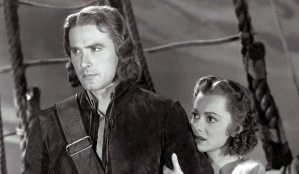
Image Credit: Warner Bros/First National/Kobal/Shutterstock This was both Flynn and de Havilland’s first major picture. Based on a novel by Rafael Sabatini, “Captain Blood” tells the story of Peter Blood (Flynn), a doctor wrongly convicted of being traitor and sold into slavery in Jamaica. There, his smart mouth earns him the ire of landowner Bishop, to the delight of his niece Arabella (de Havilland), who buys him. Blood and his fellow slaves eventually escape and become notorious pirates. Soon the tables are turned when Arabella is captured by another pirate, and Blood buys her to save her. This film was a huge risk for the studio, with a big budget and two mostly unknown actors as the leads. However, the affection the two felt for each other spilled over onto the screen with a chemistry that led to one of the greatest film pairings in Hollywood history. Bantering between Flynn’s brash rogue and de Havilland’s spunky heroine became a staple of their subsequent seven pairings, with consistent box office success. De Havilland also found a niche in costumed period dramas, with her gentle voice, classic beauty, and elegance. The film received five Oscar nominations, including Best Picture and Michael Curtiz as a write in for Best Director, and de Havilland received much critical praise for this early role.
-
3. Gone with the Wind (1939)
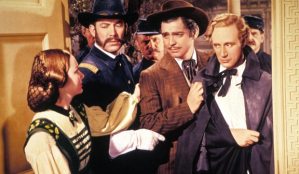
Image Credit: Moviestore/Shutterstock Producer David O. Selznick wanted de Havilland for the role of Melanie Hamilton; however, Jack Warner refused to loan her out. At a time when most actresses were fighting over the lead role of Scarlett O’Hara, de Havilland desperately wanted to play Melanie. She joined forces with Warner’s wife to fight for the role, and he finally relented, allowing her a place in one of the most legendary and beloved films in Hollywood history. In contrast to Scarlett’s fiery passion, Melanie is the more genteel character, and de Havilland plays her with a quiet strength and compassion. In what is considered the greatest year in film history, this beautiful Civil War epic received 13 Academy Award nominations, at that time the most one film had ever received – a record it would hold for a decade – and today remains in the top five of nominated films. Its eight wins include Best Picture, Best Actress (Vivien Leigh) and Best Director (Victor Fleming). De Havilland received her first nomination for this film, in the Best Supporting Actress category, but lost to costar Hattie McDaniel, who is the first African American to win an Oscar. The movie ranks in the top ten on most “must see” lists; after adjusting for inflation, it remains one of the top-grossing movies of all time; and is preserved in the National Film registry. It is one of the most quoted films of all time, and most spoofed, notably by Carol Burnett’s skit “Went with the Wind”. It remains one of the most beloved movies of all time, and its main characters are forever cemented in film history.
-
2. The Adventures of Robin Hood (1938)

Image Credit: Warner Bros/Kobal/Shutterstock There are many versions of tales of the infamous Robin Hood, but this visually stunning Technicolor classic is considered by many to be the best. Sir Robin of Locksley (Errol Flynn) forms a band of merrymen to fight Prince John (Claude Rains), who has stolen the throne from his brother and is overtaxing the Saxons. As Robin and his men continually outwit John’s men, the lovely and aristocratic Maid Marian (de Havilland), a ward of the king, sees them as horrible outlaws. However, she soon sees Robin’s true nature, and begins to help him, falling in love. As played by de Havilland, Marian was as beautiful as a fairy tale princess, but also smart and strong-willed, willing to sacrifice her life for her man. It was nominated for four Academy Awards, including Best Picture, and won three. It was one of the highest-grossing movies of 1938, is named on many “best movies ever” lists, and has been preserved in the National Film Registry. The success of this film elevated de Havilland to a new level of stardom.
-
1. The Heiress (1949)

Image Credit: Moviestore Collection/REX/Shutterstock Based on a play, “The Heiress” tells the story of plain and shy Catherine Sloper (de Havilland), who remains unmarried despite being the sole heir in a wealthy family. She is wooed by the handsome Morris Townsend (Montgomery Clift). However, her stern and emotionally distant father (Ralph Richardson) thinks he is a fortune hunter, and tells his daughter in a most unkind way that a man like that would only be interested in her money. Catherine transforms from shy insecure girl, to a young woman blossoming from her love of a man, to disillusioned spinster, to hardened yet confident mature woman. De Havilland brilliantly conveys these stages through subtle changes in demeanor and through her expressive eyes. In one pivotal scene, director William Wyler packed books into suitcases Catherine has to drag back upstairs, adding to her heavy-hearted demeanor; the contrast between this scene and her final descent up the stairs at the end embodies the life de Havilland brought to this role. The film received eight Academy Award nominations, including Best Picture and Best Director, and won four, including Best Actress for de Havilland. In addition to her second Oscar in three years, de Havilland won a Golden Globe and the New York Film Critic Circle Award.

